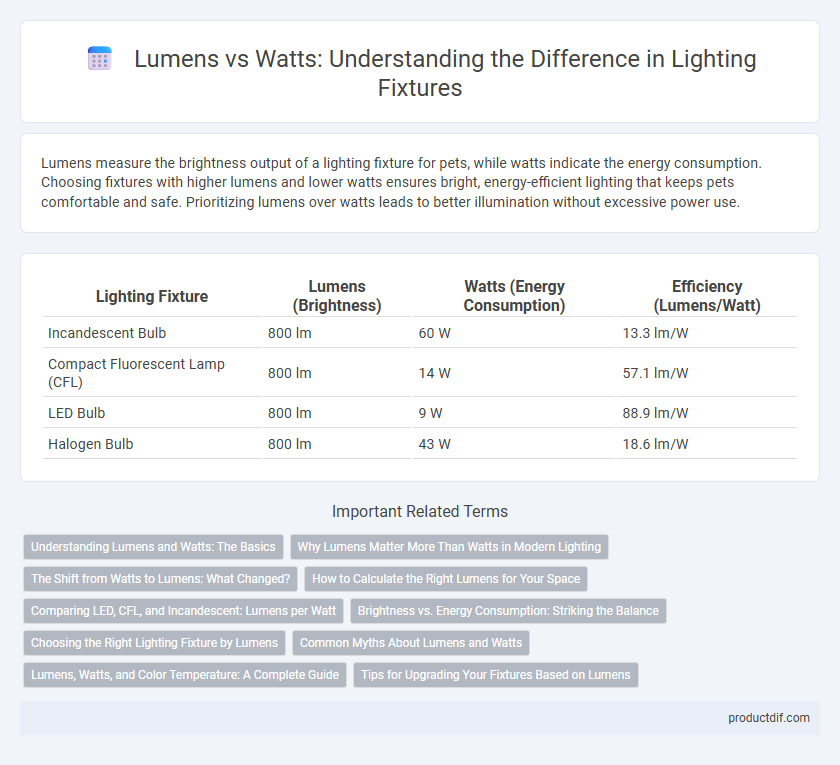Lumens measure the brightness output of a lighting fixture for pets, while watts indicate the energy consumption. Choosing fixtures with higher lumens and lower watts ensures bright, energy-efficient lighting that keeps pets comfortable and safe. Prioritizing lumens over watts leads to better illumination without excessive power use.
Table of Comparison
| Lighting Fixture | Lumens (Brightness) | Watts (Energy Consumption) | Efficiency (Lumens/Watt) |
|---|---|---|---|
| Incandescent Bulb | 800 lm | 60 W | 13.3 lm/W |
| Compact Fluorescent Lamp (CFL) | 800 lm | 14 W | 57.1 lm/W |
| LED Bulb | 800 lm | 9 W | 88.9 lm/W |
| Halogen Bulb | 800 lm | 43 W | 18.6 lm/W |
Understanding Lumens and Watts: The Basics
Lumens measure the amount of light emitted by a lighting fixture, indicating its brightness, while watts quantify the energy consumption of the bulb. Choosing lighting based on lumens ensures sufficient illumination without relying solely on wattage, which only reflects power usage. Modern LED fixtures offer high lumens with low watts, maximizing energy efficiency and brightness.
Why Lumens Matter More Than Watts in Modern Lighting
Lumens measure the actual brightness emitted by a lighting fixture, making them a more accurate indicator of light output than watts, which only quantify energy consumption. Modern lighting technology, such as LEDs, delivers higher lumens at lower wattages, emphasizing efficiency over energy use. Understanding lumens helps consumers choose fixtures that provide optimal illumination while minimizing electricity costs.
The Shift from Watts to Lumens: What Changed?
The shift from watts to lumens reflects the transition from measuring energy consumption to quantifying light output for lighting fixtures. Lumens indicate the actual brightness emitted by a bulb, providing a more accurate comparison of efficiency between LED, fluorescent, and incandescent lights. This change enables consumers to select lighting based on brightness needs rather than power usage, aligning with advances in energy-efficient technologies.
How to Calculate the Right Lumens for Your Space
To calculate the right lumens for your space, first determine the square footage of the room by multiplying length by width. Next, multiply the area by the recommended lumens per square foot based on the room type: 20 lumens for bedrooms, 30 lumens for living rooms, and up to 50 lumens for task-oriented spaces like kitchens. Avoid relying solely on watts, as lumens measure actual brightness, ensuring efficient lighting tailored to your space's needs.
Comparing LED, CFL, and Incandescent: Lumens per Watt
LED lighting delivers the highest efficiency, producing around 80-100 lumens per watt, significantly outperforming CFLs, which average 45-70 lumens per watt. Incandescent bulbs lag considerably behind, offering only 10-17 lumens per watt. This efficiency gap directly impacts energy consumption and brightness output, making LEDs the preferred choice for eco-friendly and cost-effective illumination.
Brightness vs. Energy Consumption: Striking the Balance
Lumens measure the brightness of a lighting fixture, indicating the total amount of visible light emitted, while watts quantify energy consumption. Choosing fixtures with high lumens and low watts maximizes brightness efficiency, reducing electricity costs and environmental impact. Balancing lumens and watts ensures optimal lighting performance without excessive energy use, promoting sustainability.
Choosing the Right Lighting Fixture by Lumens
Lumens measure the brightness of a lighting fixture, making them the key factor when selecting lights for specific needs, unlike watts which indicate energy consumption. Choosing fixtures based on lumens ensures optimal illumination tailored to the space, whether for task lighting with higher lumens or ambient settings with lower ones. Prioritizing lumens over watts leads to more energy-efficient lighting solutions without compromising on brightness.
Common Myths About Lumens and Watts
Lumens measure the brightness of a lighting fixture, while watts indicate the energy consumption, not light output. Common myths include the misconception that higher watts always mean brighter light, which is inaccurate due to advances in LED technology. Understanding lumens helps consumers select fixtures that provide sufficient illumination efficiently, avoiding over-reliance on wattage as an indicator of brightness.
Lumens, Watts, and Color Temperature: A Complete Guide
Lumens measure the brightness of a lighting fixture, indicating how much light it emits, while watts reflect energy consumption rather than light output. Color temperature, expressed in Kelvins (K), affects the ambiance by altering the light's warmth or coolness, with lower values producing warm, yellow tones and higher values generating cool, blue hues. Understanding lumens alongside watts and color temperature helps select energy-efficient fixtures that deliver the desired brightness and mood for any space.
Tips for Upgrading Your Fixtures Based on Lumens
When upgrading lighting fixtures, prioritize lumens over watts to ensure optimal brightness and energy efficiency; aim for higher lumens for well-lit spaces without increasing power consumption. Replace outdated bulbs with LED options offering 800 to 1600 lumens for standard rooms, balancing illumination and energy savings effectively. Consider fixture compatibility and desired ambiance when selecting lumens to maintain functional and aesthetically pleasing lighting.
Lumens vs Watts Infographic

 productdif.com
productdif.com